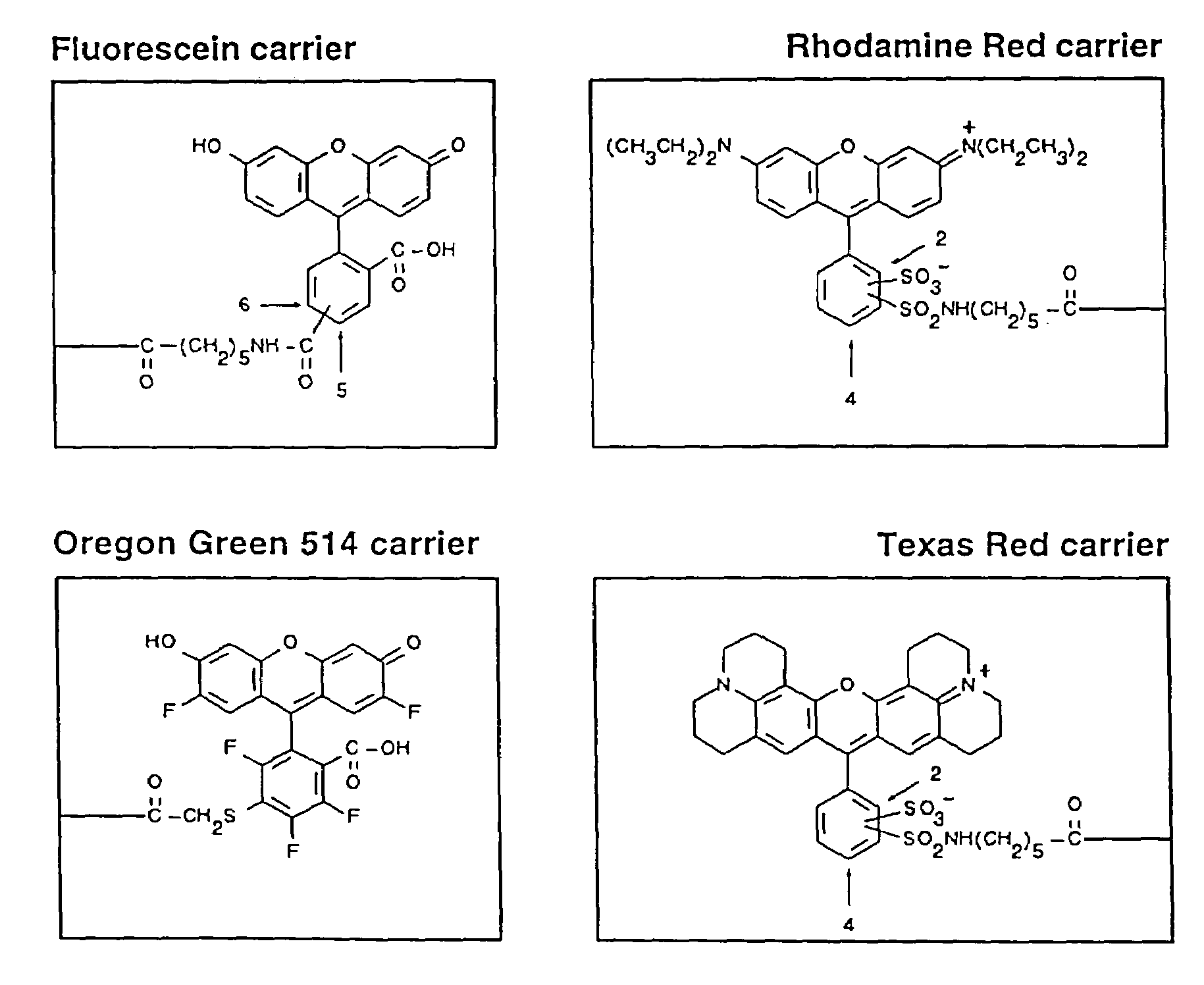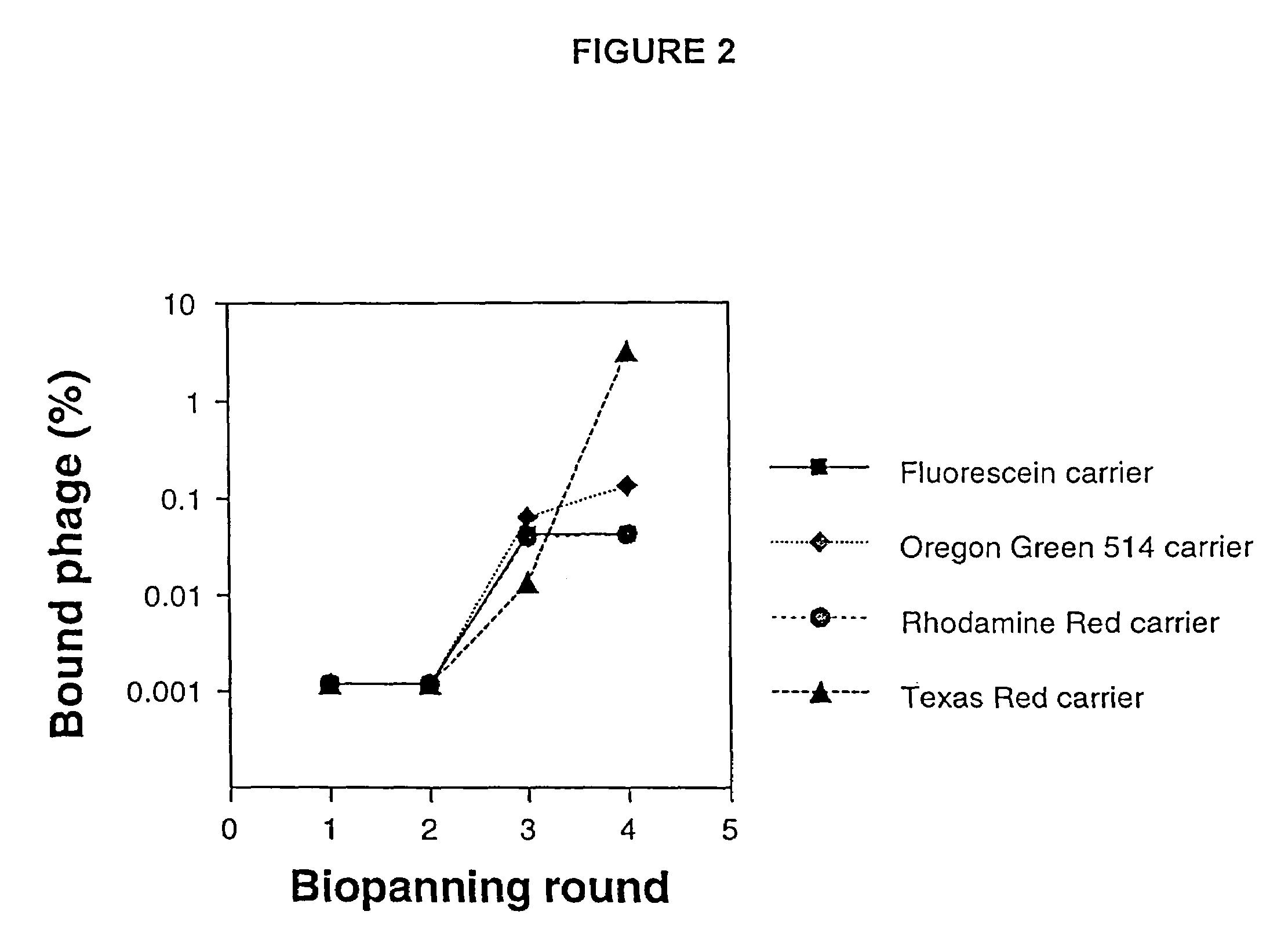Fluorescent dye binding peptides
a technology of fluorescence dye and peptide, which is applied in the field of peptides, can solve the problems of affecting the functionality of the protein in question, affecting the stability of the protein, and unable to create such reagent technology, and achieves the effect of increasing the binding affinity of the fluor
- Summary
- Abstract
- Description
- Claims
- Application Information
AI Technical Summary
Problems solved by technology
Method used
Image
Examples
example 1
Synthesis of Fluorophore Dye Carriers
[0126]Four fluorophore dyes, Texas Red, Fluorescein, Rhodamine Red and Oregon Green 514, were chosen, for selection of fluorettes from a phage display library (Example 2). The chemical structures of the dye conjugates are shown in FIG. 1. The first three dyes, Texas Red, Fluorescein and Rhodamine Red fall into one group: (i) they have a relatively high molar extinction coefficient for absorption and excellent quantum fluorescence yields (Haugland supra), (ii) they have non-overlapping spectral characteristics, (iii) they have the potential for cross-quenching and / or FRET analysis. The fourth dye, Oregon Green 514, related structurally to Fluorescein, was chosen to determine if structure-function relationships could be discerned between fluorette peptides that bound related dyes.
[0127]The extinction coefficient and quantum yield is important for sensitivity of detection and was a major factor determining choice of fluorophores. Fluorescence detect...
example 2
Selection for Peptide Aptamers that Bind Small Molecule Fluorophores
[0131]A phage display peptide library was screened that contained a combinatorial library of 12-mer peptides fused via a short glycine linker spacer (GGG) to the amino-terminus of a minor coat pIII protein (5 copies per particle, Li et al. (1980) J. Biol. Chem. 255:10331-10337) of the filamentous bacteriophage M13mp19 (Ph.D. phage display, New England Biolabs). During phage maturation, the leader secretory sequence is removed. This results in the 12-mer peptide positioned immediately at the amino-terminus of the mature protein.
[0132]E. coli ER2537 strain [F′ laclq Δ(lacZ)M15 proA+B+ / fhuA2 supE thi Δ(lac-proAB) Δ(hsdSM-mcrB)5 (rk− mk− mcrBC−)] and E.coli TG-1 strain [supE thi-1 Δ(lac-proAB) Δ(mcrB-hsdSM)5 (rk− mk−) (F′ traD36 proAB laclqZΔM15)] were purchased from New England Biolabs and Stratagene, respectively, and used as bacteriophage M13mp19 hosts. All bacteriological techniques were performed as described (Samb...
example 3
Forced Evolution of Higher Affinity Fluorophore-Binding Peptides
[0145]The total number of possible random 12-mer peptides is equal to 2012=4.1×1015. The complexity of the phage display peptide library used for biopanning against the fluorophore dye carriers was much smaller, containing only 1.9×109 clones. Thus, the library represents a fraction of all possible 12-mer peptides that could have been searched for binding. We therefore sought to improve the present fluorettes. We chose to introduce mutations into the fluorette peptide sequences at the DNA level in the phage and then select for phage that displayed peptides with higher affinity (compared to the parent) against the respective fluorophore dye carrier. We chose the Texas Red- and Rhodamine Red-specific clones (TR401 and RhR401, respectively), as well as the predominant Oregon Green 514- and Fluorescein-specific fluorette clones (OG403 and OG402, respectively, see above), for this forced evolution based on initial indication...
PUM
| Property | Measurement | Unit |
|---|---|---|
| binding constant | aaaaa | aaaaa |
| pH | aaaaa | aaaaa |
| pH | aaaaa | aaaaa |
Abstract
Description
Claims
Application Information
 Login to View More
Login to View More - R&D
- Intellectual Property
- Life Sciences
- Materials
- Tech Scout
- Unparalleled Data Quality
- Higher Quality Content
- 60% Fewer Hallucinations
Browse by: Latest US Patents, China's latest patents, Technical Efficacy Thesaurus, Application Domain, Technology Topic, Popular Technical Reports.
© 2025 PatSnap. All rights reserved.Legal|Privacy policy|Modern Slavery Act Transparency Statement|Sitemap|About US| Contact US: help@patsnap.com



